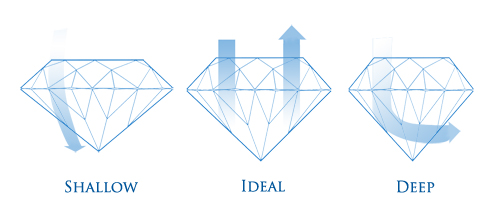Of
the four Cs which determine quality, diamond cut is the most complex
to understand as well as the most important characteristic in choosing a diamond.
The cut refers not only to the diamond's proportions and
symmetry, but also to the
delicate crafting of each and every facet. The combination of these factors, together
with the polish and overall finish is known as the cut of the diamond.
The cut of a diamond is often related to the final
diamond shape but not always.
Diamond Proportions
Diamond Vocabulary
To understand some of the finer points of diamond cuts, it's necessary to first
understand some basic diamond vocabulary.
|
Diameter
|
The width of the diamond from one side of the girdle to the other.
|
|
|
|
Table
|
The large facet (face) at the top of the diamond
|
|
|
|
Girdle
|
The edge of the diamond between the crown and the pavilion. the girdle is the area
of the diamond with the largest circumference
|
|
|
|
Crown
|
The top part of the diamond from the girdle to the table
|
|
|
|
Culet
|
The minute facet on the bottom tip of the diamond
|
|
|
|
Pavilion
|
The part of the diamond from underneath the girdle to the culet
|
|
|
|
Depth
|
The diamond measurement from the table to the culet
|
Let the Light Shine Through
Every diamond has its own, unique proportions which directly affect the way light
travels through the diamond and is reflected back up through the table. This, in
turn, influences the sparkle, or brilliance, of the diamond and its perceived beauty.
In fact, the cut of a diamond, far more than its color or clarity, affects its splendor.
If a diamond is cut too shallow, light can escape from underneath, reducing the
brilliance. If the cut is too deep, light can spread out from the sides, again affecting
the sparkle. A diamond with good proportions will allow the light to travel inside
the diamond, reflecting the light through the table and crown for maximum sparkle.

The sparks or small flashes of light often seen as a diamond moves are otherwise
known as scintillation. As well as brilliance, which is essentially the amount of
white light reflected by the diamond, the cut also influences the amount of fire
and scintillation of the diamond. The fire is the way the light is refracted by
the diamond, splitting it into the beautiful colors of the rainbow.
Diamond Cut Grades at Israel-Diamonds.com
At Israel-Diamonds, our diamonds are graded for cut according to the following scale:
Excellent - E
Very Good - VG
Good - G
We do not sell any diamonds with a Fair or Poor cut grade.
Excellent Cut: Our highest
cut grade, this diamond is cut with proportions which allow the maximum brilliance
to shine through.
Very Good Cut: This diamond
has first-rate proportions and offers outstanding sparkle and brilliance at a cost-effective
price.
Good Cut: A fine diamond, offering
significant sparkle and brilliance. This grade represents excellent value for money.
Diamonds which have a
GIA or EGL Report
are graded according to the scale of those organizations.
What Cut Is Best For You?
Diamond cut, within a range of recommended guidelines, is mostly a matter of personal
preference. What looks beautiful to you may look less so to someone else. Some people
may prefer the look of a larger table, for instance, while others will prefer a
smaller table. At Israel-Diamonds we offer photos of the actual diamonds so you
can decide for yourself.




